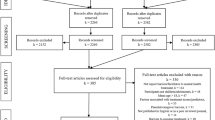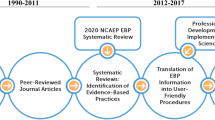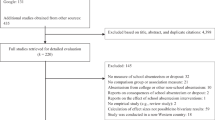Abstract
Purpose of Review
Half of states in the USA have legislation requiring that schools conduct body mass index (BMI) screening among students; just under half of these states report results to parents. The effectiveness of school-based BMI screening and reporting in reducing childhood obesity is not established and the practice has raised concerns about the potential for increased weight-based stigmatization.
Recent Findings
Recent experimental studies of BMI screening and reporting have not demonstrated a positive impact on students’ weight status. However, the language and formatting of BMI reports used in studies to date have been suboptimal and have likely limited the potential effectiveness of the practice.
Summary
This article reviews the recent literature on school-based BMI screening and reporting and highlights important areas for future inquiry. The present review suggests that evidence to date is not sufficient to support definitive conclusions about the value of school-based BMI screening and reporting as a childhood obesity prevention tool.
Similar content being viewed by others
References
Papers of particular interest, published recently, have been highlighted as: • Of importance •• Of major importance
Ogden CL, Carroll MD, Kit BK, Flegal KM. Prevalence of obesity and trends in body mass index among US children and adolescents, 1999-2010. JAMA. 2012;307(5):483–90.
Madsen KA, Weedn AE, Crawford PB. Disparities in peaks, plateaus, and declines in prevalence of high BMI among adolescents. Pediatrics. 2010;126(3):434–42.
Institute of Medicine of the National Academies. Preventing childhood obesity. Health in the balance [executive summary]. Washington: The National Academies Press; 2005.
•• Ruggieri DG, Bass SB. A comprehensive review of school-based body mass index screening programs and their implications for school health: do the controversies accurately reflect the research? The Journal of School Health. 2015;85(1):61–72. Recent comprehensive review on BMI screening and reporting in schools
Dietz WH, Story MT, Leviton LC. Issues and implications of screening, surveillance, and reporting of children’s BMI. Pediatrics. 2009;124(Suppl 1):S98–101.
Soto C, White JH. School health initiatives and childhood obesity: BMI screening and reporting. Policy Polit Nurs Pract. 2010;11(2):108–14.
Evans EW, Sonneville KR. BMI report cards: will they pass or fail in the fight against pediatric obesity? Curr Opin Pediatr. 2009;21(4):431–6.
Ikeda JP, Crawford PB, Woodward-Lopez G. BMI screening in schools: helpful or harmful. Health Educ Res. 2006;21(6):761–9.
Madsen KA, Linchey J. School-based BMI and body composition screening and parent notification in California: methods and messages. The Journal of School Health. 2012;82(6):294–300.
• Moyer LJ, Carbone ET, Anliker JA, Goff SL. The Massachusetts BMI letter: a qualitative study of responses from parents of obese children. Patient Educ Couns. 2014;94(2):210–7. Qualitative study with racially diverse parents of overweight and obese Massachusetts students who were part of state’s mandated BMI screening and reporting program
Johnson A, Ziolkowski GA. School-based body mass index screening program. Nutr Today. 2006;41(6):274–9.
Thompson JW, Card-Higginson P. Arkansas’ experience: statewide surveillance and parental information on the child obesity epidemic. Pediatrics. 2009;124(Suppl 1):S73–82.
Madsen KA. School-based BMI screening and parent notification: a statewide natural experiment. Archives of Pediatrics & Adolescent Medicine. 2011;165(11):987–92.
• Thompson HR, Linchey JK, Madsen KA. Critical elements of a school report to parents on body mass index. Prev Chronic Dis. 2015;12:E136. Qualitative work with diverse group of California parents to inform best practices for BMI reporting. Reports will be used in a large-scale randomized controlled trial to test the impact and unintended consequences of BMI screening and reporting.
•• Almond D, Lee A, Schwartz AE. Impacts of classifying New York City students as overweight. Proc Natl Acad Sci U S A. 2016;113(13):3488–91.16. Analysis involving more than 3,500,000 New York City students examining impact of BMI screening and reporting on student weight status
Doolen J, Alpert PT, Miller SK. Parental disconnect between perceived and actual weight status of children: a metasynthesis of the current research. J Am Acad Nurse Pract. 2009;21(3):160–6.
Ruggieri DG, Bass SB. African-American parents’ knowledge and perceptions about BMI measurements, school-based BMI screening programs, and BMI report cards: results from a qualitative investigation and implications for school-to-parent communication. J Racial Ethn Health Disparities. 2016;3(2):320–30.
Dietz WH, Story MT, Leviton LC. Introduction to issues and implications of screening, surveillance, and reporting of children’s BMI. Pediatrics. 2009;124(Suppl 1):S1–2.
• Li W, Buszkiewicz JH, Leibowitz RB, Gapinski MA, Nasuti LJ, Land TG. Declining trends and widening disparities in overweight and obesity prevalence among Massachusetts public school districts, 2009-2014. Am J Public Health. 2015;105(10):e76–82. Although not designed to assess the impact of BMI reporting, this study assesses youth obesity prevalence in Massachusetts, coincident with the implementation of school-based screening and reporting.
•• Gee KA. School-based body mass index screening and parental notification in late adolescence: evidence from Arkansas’s Act 1220. J Adolesc Health. 2015;57(3):270–6. Arkansas has the country’s longest-running, best-studied school-based BMI screening and reporting program and this study looks at the program’s impact on student weight status in high school.
Bidwell A. Massachusetts schools to stop sending ‘fat letters’. US News and World Report. 2013.
•• Prina S, Royer H. The importance of parental knowledge: evidence from weight report cards in Mexico. J Health Econ. 2014;37:232–47. Randomized controlled trial assessing impact of BMI reporting in Mexican primary schools
Elgar FJ, Stewart JM. Validity of self-report screening for overweight and obesity. Evidence from the Canadian Community Health Survey. Can J Public Health. 2008;99(5):423–7.
Fitzgibbon ML, Beech BM. The role of culture in the context of school-based BMI screening. Pediatrics. 2009;124(Suppl 1):S50–62.
Keough L. Caregivers and underserved minority populations: views and opinions of the role of schools in BMI screening, education, and communication. Journal of Health Disparities Research and Practice. 2015;8(3):80–95.
Cogan JC, Smith JP, Maine MD. The risks of a quick fix: a case against mandatory body mass index reporting laws. Eat Disord. 2008;16(1):2–13.
Crawford PB, Hinson J, Madsen KA, Neumark-Sztainer D, Nihiser AJ. An update on the use and value of school BMI screening, surveillance, and reporting. Childhood Obesity. 2012;7(6):441–9.
Grimmett C, Croker H, Carnell S, Wardle J. Telling parents their child’s weight status: psychological impact of a weight-screening program. Pediatrics. 2008;122(3):e682–8.
Hayes D. BMI report cards: more harm than good? The Huffington post. 2013. Available at http://www.huffingtonpost.com/dayle-hayes-ms-rd/bmi-report-cards-more-harm-than-good_b_3797678.html. Accessed on December 5, 2016 August 23, 2013.
Portilla MG. Body mass index reporting through the school system: potential harm. J Am Diet Assoc. 2011;111(3):442–5.
ABC News. ‘Fat letters’ worry students, parents and experts. September 3, 2013. Available at https://gma.yahoo.com/blogs/abc-blogs/fat-letters-worry-students-parents-experts-124101086--abc-news-health.html. Accessed on December 5, 2016.
Kaczmarski JM, DeBate RD, Marhefka SL, Daley EM. State-mandated school-based BMI screening and parent notification: a descriptive case study. Health Promot Pract. 2011;12(6):797–801.
Lee J, Kubik MY. Child’s weight status and parent’s response to a school-based body mass index screening and parent notification program. J Sch Nurs. 2015;31(4):300–5.
Schwartz M. Parental perceptions of body mass index notification: a qualitative study. The Journal of School Health. 2015;85(10):714–21.
Hunsberger M, McGinnis P, Beamer BA, Smith J. Student and parental perceptions of school-based body mass index screening and notification. Journal of Community Medicine and Health Education. 2014;S2:1–6.
Johnston JC, McNeil DA, Best M, MacLeod C. A growth status measurement pilot in four Calgary area schools: perceptions of grade 5 students and their parents. J Sch Nurs. 2011;27(1):61–9.
Centers for Disease Control and Prevention. The National Health and Nutrition Examination Survey. Available at https://www.cdc.gov/nchs/nhanes/. Accessed on December 5, 2016.
Cheng JK. Confronting the social determinants of health—obesity, neglect, and inequity. N Engl J Med. 2012;367(21):1976–7.
Heelan KA, Bartee RT, Nihiser A, Sherry B. Healthier school environment leads to decreases in childhood obesity: the Kearney Nebraska story. Child Obes. 2015;11(5):600–7.
Ogden CL, Carroll MD, Kit BK, Flegal KM. Prevalence of childhood and adult obesity in the United States, 2011-2012. JAMA. 2014;311(8):806–14.
Willi SM, Hirst K, Jago R, Buse J, Kaufman F, El Ghormli L, et al. Cardiovascular risk factors in multi-ethnic middle school students: the HEALTHY primary prevention trial. Pediatr Obes. 2012;7(3):230–9.
Gortmaker SL, Peterson K, Wiecha J, Sobol AM, Dixit S, Fox MK, et al. Reducing obesity via a school-based interdisciplinary intervention among youth: planet health. Archives of Pediatrics & Adolescent Medicine. 1999;153(4):409–18.
Acknowledgements
The authors are supported by the National Institutes of Health (NIH) grant R01HL120666.
Author information
Authors and Affiliations
Corresponding author
Ethics declarations
Conflict of Interest
Hannah R. Thompson and Kristine A. Madsen declare they have no conflict of interest.
Human and Animal Rights and Informed Consent
This article does not contain any studies with human or animal subjects performed by any of the authors.
Additional information
This article is part of the Topical Collection on Obesity Prevention
Rights and permissions
About this article
Cite this article
Thompson, H.R., Madsen, K.A. The Report Card on BMI Report Cards. Curr Obes Rep 6, 163–167 (2017). https://doi.org/10.1007/s13679-017-0259-6
Published:
Issue Date:
DOI: https://doi.org/10.1007/s13679-017-0259-6




